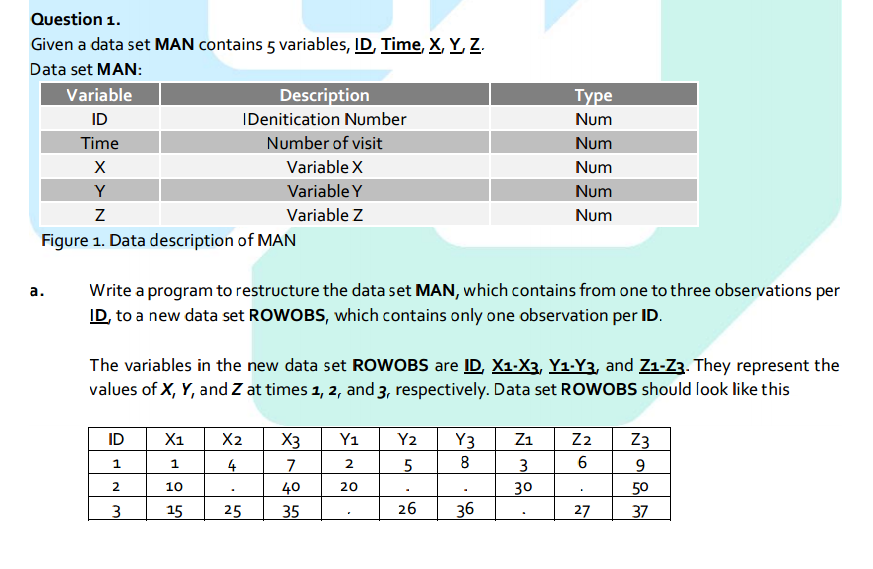Turn on suggestions
Auto-suggest helps you quickly narrow down your search results by suggesting possible matches as you type.
Showing results for
- Home
- /
- Programming
- /
- Programming
- /
- SAS Array procedure
Options
- RSS Feed
- Mark Topic as New
- Mark Topic as Read
- Float this Topic for Current User
- Bookmark
- Subscribe
- Mute
- Printer Friendly Page
- Mark as New
- Bookmark
- Subscribe
- Mute
- RSS Feed
- Permalink
- Report Inappropriate Content
Posted 11-30-2015 07:45 AM
(2286 views)

7 REPLIES 7
- Mark as New
- Bookmark
- Subscribe
- Mute
- RSS Feed
- Permalink
- Report Inappropriate Content
Below is a way to do it using a macro and the Transpose Procedure and then merging the transposed data sets together. It should get you what you are looking for in the output data. If arrays are required, that can be adjusted too.
data have;
input ID$ Time X Y Z;
datalines;
1 10 1 2 3
1 11 4 5 6
1 12 7 8 9
2 13 10 20 30
2 14 . . .
2 15 40 . 50
3 16 15 . .
3 17 25 36 37
3 18 35 36 37
;
run;
proc sort data=have;
by ID;
run;
%macro transpose(var,n);
%if &n^=3 %then %do;
proc transpose data=have prefix=&var out=want_&var (drop=_NAME_);
by ID;
var &var;
run;
%end;
%else %do;
proc transpose data=have prefix=&var out=want_&var (drop=_NAME_);
by ID;
var &var;
run;
data want;
merge want_X want_Y want_&var;
run;
%end;
%mend;
%transpose(X,1)
%transpose(Y,2)
%transpose(Z,3);- Mark as New
- Bookmark
- Subscribe
- Mute
- RSS Feed
- Permalink
- Report Inappropriate Content
thank you for your help and good answer. however, marco, proc transpose are not allowed. i can only use array data step to do it. sorry .
- Mark as New
- Bookmark
- Subscribe
- Mute
- RSS Feed
- Permalink
- Report Inappropriate Content
here is my raw data file, in my google drive
https://drive.google.com/open?id=0BzqllIWlzJosWGZSdmkzZ0RIeDA
https://drive.google.com/open?id=0BzqllIWlzJosWGZSdmkzZ0RIeDA
- Mark as New
- Bookmark
- Subscribe
- Mute
- RSS Feed
- Permalink
- Report Inappropriate Content
I think you can find the solution in this article (see Example 1 there).
- Mark as New
- Bookmark
- Subscribe
- Mute
- RSS Feed
- Permalink
- Report Inappropriate Content
thank you very much. let me study it first. really appreciate your help
- Mark as New
- Bookmark
- Subscribe
- Mute
- RSS Feed
- Permalink
- Report Inappropriate Content
libname rawfile 'c:\';
run;
proc sort data=rawfile.man;
by id;
run;
data ROWOBS;
set rawfile.man;
by id;
array x_var(3) X1-X3 ;
array y_var(3) Y1-Y3 ;
array z_var(3) Z1-Z3;
if first.id then do i = 1 to 3;
x_var(i) = .;
y_var(i) = .;
z_var(i) = .;
end;
j = time;
x_var(j) = x;
y_var(j) = y;
z_var(j) = z;
if last.id then output;
retain x1-x3 y1-y3 z1-z3;
drop i j time x y z;
run;
run;
proc sort data=rawfile.man;
by id;
run;
data ROWOBS;
set rawfile.man;
by id;
array x_var(3) X1-X3 ;
array y_var(3) Y1-Y3 ;
array z_var(3) Z1-Z3;
if first.id then do i = 1 to 3;
x_var(i) = .;
y_var(i) = .;
z_var(i) = .;
end;
j = time;
x_var(j) = x;
y_var(j) = y;
z_var(j) = z;
if last.id then output;
retain x1-x3 y1-y3 z1-z3;
drop i j time x y z;
run;
- Mark as New
- Bookmark
- Subscribe
- Mute
- RSS Feed
- Permalink
- Report Inappropriate Content
Here's a good walk through for future reference.
http://www.ats.ucla.edu/stat/sas/modules/widetolong_data.htm
http://www.ats.ucla.edu/stat/sas/modules/widetolong_data.htm
April 27 – 30 | Gaylord Texan | Grapevine, Texas
Registration is open
Walk in ready to learn. Walk out ready to deliver. This is the data and AI conference you can't afford to miss.
Register now and lock in 2025 pricing—just $495!
How to Concatenate Values
Learn how use the CAT functions in SAS to join values from multiple variables into a single value.
Find more tutorials on the SAS Users YouTube channel.
SAS Training: Just a Click Away
Ready to level-up your skills? Choose your own adventure.



